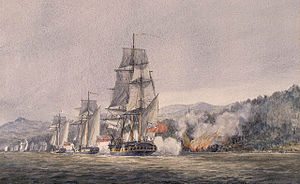Battle of Valcour Island
| Battle of Valcour Island | |||||||
|---|---|---|---|---|---|---|---|
| Part of the American Revolutionary War | |||||||
 Royal Savage is shown run aground and burning, while British ships fire on her (watercolor by unknown artist, ca. 1925) |
|||||||
|
|||||||
| Belligerents | |||||||
|
|
|
||||||
| Commanders and leaders | |||||||
| Benedict Arnold |
Guy Carleton Thomas Pringle |
||||||
| Strength | |||||||
| 15 armed ships 500 sailors |
25 armed ships 697 sailors 1,000 soldiers 650 Indians |
||||||
| Casualties and losses | |||||||
| 80 killed or wounded 120 captured 11 ships lost |
40 killed or wounded 3 small gunboats lost |
||||||
The naval Battle of Valcour Island, also known as the Battle of Valcour Bay, took place on October 11, 1776, on Lake Champlain. The main action took place in Valcour Bay, a narrow strait between the New York mainland and Valcour Island. The battle is generally regarded as one of the first naval battles of the American Revolutionary War, and one of the first fought by the United States Navy. Most of the ships in the American fleet under the command of Benedict Arnold were captured or destroyed by a British force under the overall direction of General Guy Carleton. However, the American defense of Lake Champlain stalled British plans to reach the upper Hudson River valley.
The Continental Army had retreated from Quebec to Fort Ticonderoga and Fort Crown Point in June 1776 after British forces were massively reinforced. They spent the summer of 1776 fortifying those forts, and building additional ships to augment the small American fleet already on the lake. General Carleton had a 9,000 man army at Fort Saint-Jean, but needed to build a fleet to carry it on the lake. The Americans, during their retreat, had either taken or destroyed most of the ships on the lake. By early October, the British fleet, which significantly outgunned the American fleet, was ready for launch.
On October 11, Arnold drew the British fleet to a position he had carefully chosen to limit their advantages. In the battle that followed, many of the American ships were damaged or destroyed. That night, Arnold sneaked the American fleet past the British one, beginning a retreat toward Crown Point and Ticonderoga. Unfavorable weather hampered the American retreat, and more of the fleet was either captured or grounded and burned before it could reach Crown Point. Upon reaching Crown Point Arnold had the fort's buildings burned and retreated to Ticonderoga.
...
Wikipedia
